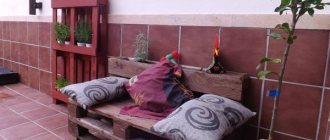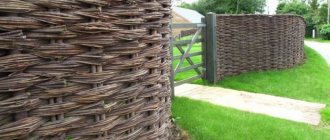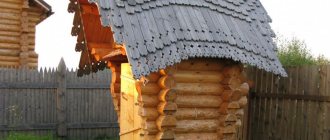Every summer resident is interested in the fact that the grape plant he planted begins to bear fruit as early as possible and enjoys abundant harvests for a longer period of time. This requires careful care of young plantings immediately after planting. Along with other measures, by the beginning of the second year of growing season, a trellis for grapes is installed, which allows the bushes to be formed correctly and the first harvest to be obtained in a timely manner.
The best types of supports for garden vines are various types of trellises
In amateur and farm vineyards, vertical single-plane trellises with several rows of wire and inclined two-plane trellises are usually used.
The purpose of such supports
Any trellis is designed to perform a number of functions:
- helps control the growth and development of culture;
- increases the overall yield from the bush;
- facilitates pruning of cultivated grapes, pest control, and harvesting of ripe crops;
- promotes competent organization of used space;
- significantly reduces the likelihood of fungal diseases, mold and various pests due to good ventilation and avoiding contact with the ground;
- proper tying will allow the bunches to receive maximum sunlight, optimal air circulation and good ripening of larger fruits;
- By tying the bushes, breaking off and any damage to the branches in bad weather is also eliminated.
In addition, modern vine supports began to be used by landscape designers as a decorative element, which is a tool for zoning and the formation of “living” hedges.
Useful tips
Beginner winegrowers may find the following tips useful:
- Do not use fishing line or thin rope when gartering. The best options are scraps of fabric, polyethylene, nylon tights or natural materials: soaked kenaf, willow shoots. In exceptional cases, wire may be used to secure the main vine.
- To ensure that the vine is fixed more firmly and does not rub against the trellis, it is recommended to use a figure eight garter, passing material between the shoot and the wire.
- The use of a garter rope and special tools for viticulture will significantly simplify the work of a novice gardener and turn it into an exciting activity.
Video: How and how to tie a grapevine
Tying up shoots is the main activity in caring for grapes. This procedure allows you to regulate the growth and direction of the vine, maintain it in a healthy condition and obtain good yields. In addition, a trellis braided with emerald greenery creates a pleasant shadow and decorates the area.
What types of trellises are there?
In general, the supporting structures under consideration are divided into two main types:
- Single-plane supports, when all shoots are located along one main plane.
- Two-plane options using two planes parallel to each other.
Attention! One of the smart solutions could be to use a ready-made grape net made of plastic.
Basic rules for creation
The trellis is close to the gazebo, but initially the functions of the two structures are different. But even based on such proximity of buildings, many summer residents and owners of private houses do not dare to install a trellis: it seems that it is very difficult. In fact, it turns out that even an absolute neophyte in dacha construction will be able to build a trellis on the site for climbing plants, for example, for clematis, actinidia, peas and others.
Here are the top tips for a novice gardener builder.
It is very important to choose the location of the trellis wisely. The main requirement is sufficient sunlight
That is, a trellis in an open area is the most common story, although this structure can also go along the house if the sun illuminates this side well. It is also worth considering that most of the time the trellis will stand bare, and this “bare” structure should not be foreign to the overall composition of the site and the objects located on it.
The design a priori has a high windage capacity. This means the support must be resistant to bending. Therefore, the builder takes into account the wind speed and its frequency (and whether it is worth building a trellis in this place at all), he calculates, and what parts of the trellis should be - aboveground and underground.
Rods and support rails must be thoroughly secured. To do this, rigid materials with an optimal strength margin are taken; they must easily withstand the weight of the crops that will live on the trellis.
If the design is complicated by moving elements, adjustment of its height and width will be available. But this is not always necessary.
These are the main points that must be provided for, calculated and negotiated during construction. Everything else is optional. The materials taken for the trellis must be organic and in tune with other objects on the site. Heterogeneity is acceptable if the owner has excellent taste and obvious design inclinations: then he will know how to combine very different textures, materials, colors, and other aspects in one place. But usually people do not look for too complex, extraordinary solutions, preferring classic examples. For example, a wooden trellis, ideal for flowers.
Pros and cons of single-plane support
This support is considered the simplest design, because its manufacture requires only support pillars, between which stainless steel wire is stretched in several parallel rows.
It is important! The distance between the post and the plant itself should be at least 30 cm to facilitate caring for the crop.
In this case, the bottom row is located at a height of 60 to 100 cm from the surface of the earth, and approximately 30 or 40 cm are left between the rest. As the bush develops, the shoots are simply tied to a tensioned wire.
One of the varieties of a single-plane support can also be considered a structure with a canopy (in the shape of the letter G), i.e. the horizontal top element will increase the usable area when forming a vine. This also includes designs in the form of semi-arches.
The positive aspects of such structures are:
- low cost and maximum ease of installation;
- good ventilation and lighting of plants is achieved;
- ease of pruning and care, including shelter for the winter;
- Between such rows, gardeners can plant vegetables or flowers, thus saving space.
The negative side of such a support for grapes is that it will not be possible to tie a large number of bushes to it and it cannot be used for vigorous grape varieties.
How to tie grapes
In the spring, carefully bend the branches of the plant to the supports and fix the replacement knots. In the summer, repeat the operation with young shoots. For tying, use soft material: rags, old nylon or nylon stockings. Gardening stores sell special tapes.
Nylon and nylon are the best materials for tying because as the vines grow they stretch without damaging the shoots. During the procedure, pass the material in a figure eight pattern: this prevents the branches from rubbing against the wire. Lay the vines horizontally or in an arc. Tie the lower shoots loosely and the upper shoots tightly.
Characteristics of two-plane supports
Depending on the varietal characteristics, they practice the use of straight (U-shaped), V-, Y-shaped structures in two planes, allowing the formation of a bush on two supports at once.
If a U-shaped option is chosen, the distance between the generatrices cannot be less than 50-65 cm in order to maintain the possibility of full treatment with chemicals. And it is recommended to make the total height up to 2 m.
Among the advantages of such structures are:
- this makes it easier to grow more fruit-bearing, vigorous-growing varieties of crops;
- undoubtedly, it is easier to achieve an increase in the volume of harvested crops;
- natural pollination of plants improves;
- significant space savings are achieved.
Among the disadvantages, experts note the inconvenience of covering non-frost-resistant varieties (for this you will have to partially dismantle part of the structure), high labor intensity and material costs.
To avoid strong shading, these types of supports can be placed exclusively from north to south.
Semi-arches, arched options or pergolas are chosen when you want to get shaded canopies for relaxation. Among the disadvantages of arches are high cost, sufficient dimensions and difficulty in manufacturing. And to collect the crop from the upper rungs you will need to stock up on a stepladder.
What are the features of the green garter?
This type of garter must be carried out in mid-summer, when the young shoots reach a length of 40 to 50 cm. The essence of this procedure is to preserve the integrity of the fertile parts.
Strong wind and rain can cause the death of the plant. It is recommended to do the green garter at an angle of 90 degrees.
This method can be used to fix adult bushes, in which young lashes can reach 3 m.
As they grow, the long parts must be fixed on a metal wire or trellis. Experts recommend gartering before the berry clusters form.
It is important to carry out the final gartering of cultivated grapes before fruiting begins. Thus, on average, 3 to 4 manipulations will be required.
Materials used
If a gardener has a question about how to make a trellis for his grapes, he should still familiarize himself with its varieties and the materials used.
For the main pillars, wood (oak, chestnut or ash) or metal pipes are often used. For partitions, you can use reinforcement, plastic pipes, wooden blocks, and wire. Wooden materials will have to be treated with antiseptics annually.
There are many options and schemes that allow you to choose the best support structure for your cultivated grapes.
Just remember that such trellises are not temporary structures that can be moved to other places. Therefore, choosing the right site is crucial here.
When is the best time to tie?
Work on tying up grapes should begin in early spring, immediately after the bushes open. It is important not to miss the moment when the juices begin to flow. During this period, the vine becomes flexible, plastic and easily shaped in the desired direction. You need to finish the garter before the buds open - at the beginning of their growth they are too fragile and are easily damaged during the procedure. Also, several more garters will be required during the summer as new shoots grow.
Also learn about ways to cover grapes for the winter.
Possible manufacturing errors
When organizing a vineyard, you need to think through various details, choose a location, type of trellis and grape variety.
Possible mistakes:
- The space is not organized correctly, the vines interfere with other plants or the trees create a shadow for the grapes.
- There is too much space between rows that is difficult to use in other ways.
- There is too little space between the rows, resulting in inconvenient processing of the vine.
- A small distance between plants results in the bushes interfering with each other, and poor air exchange contributes to diseases.
- The wrong type of trellis was chosen for a particular variety - a vigorous one is not suitable for a single-plane trellis, and a covering one is not suitable for a two-plane one.
- If the drawing is not made and the dimensions are not selected, the trellis may not be installed correctly.
- Pre-treatment of materials, wood from fungus, metal from rust, has not been done, which significantly reduces the service life of the support.
- The supports are too high, they are problematic to maintain, and it is difficult to prune the vines and harvest the crop.
Anyone can make a beautiful, functional trellis for grapes. The main thing is to choose the right plot of land and material for support. When choosing the type of support, take into account the variety of grapes that you plan to grow on it. Don’t forget to take care of the trellis every year, trim the vines, clean the supports from dirt and dust, treat them with anti-corrosion (for metal) and antifungal (for wood) preparations.
Choosing a site for planting ornamental varieties
Decorative grapes do not require careful selection and certain lighting or soil parameters. It can be considered one of the most unpretentious and hardy plants for the garden. Possessing a high adaptive ability, it can survive on poor or completely infertile soils.
You can choose both sunny places suitable for light-loving garden crops, and the shady sides of buildings. More details on how to choose a suitable place on a plot for grapes are described in a separate article. Lianas tolerate shade well, but feel better when they are illuminated by the sun for at least a few hours a day. Planting in partial shade will be most effective. In such conditions, the plant shows powerful growth and dense foliage.
Important! Maiden grapes can grow in any conditions, but their decorative properties directly depend on the lighting. The more the plant is in the sun, the faster the vine grows, the brighter the color of the leaves.
Planting can be done in any soil, even dry and rocky. All that is required is compliance with basic rules of agricultural technology. The existing deficiencies of the land (from poor cultivation, density, to poverty of nutrients or excess of hardness/acidity standards) are compensated during planting. In a separate article you will learn how to properly propagate virgin grapes.











